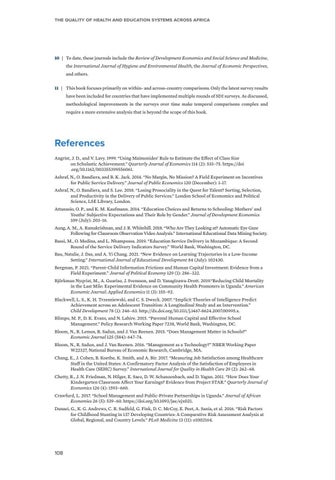The Quality of Health and Education Systems Across Africa
10 | To date, these journals include the Review of Development Economics and Social Science and Medicine, the International Journal of Hygiene and Environmental Health, the Journal of Economic Perspectives, and others. 11 | This book focuses primarily on within- and across-country comparisons. Only the latest survey results have been included for countries that have implemented multiple rounds of SDI surveys. As discussed, methodological improvements in the surveys over time make temporal comparisons complex and require a more extensive analysis that is beyond the scope of this book.
References Angrist, J. D., and V. Lavy. 1999. “Using Maimonides’ Rule to Estimate the Effect of Class Size on Scholastic Achievement.” Quarterly Journal of Economics 114 (2): 533–75. https://doi .org/10.1162/003355399556061. Ashraf, N., O. Bandiera, and B. K. Jack. 2014. “No Margin, No Mission? A Field Experiment on Incentives for Public Service Delivery.” Journal of Public Economics 120 (December): 1–17. Ashraf, N., O. Bandiera, and S. Lee. 2018. “Losing Prosociality in the Quest for Talent? Sorting, Selection, and Productivity in the Delivery of Public Services.” London School of Economics and Political Science, LSE Library, London. Attanasio, O. P., and K. M. Kaufmann. 2014. “Education Choices and Returns to Schooling: Mothers’ and Youths’ Subjective Expectations and Their Role by Gender.” Journal of Development Economics 109 (July): 203–16. Aung, A. M., A. Ramakrishnan, and J. R. Whitehill. 2018. “Who Are They Looking at? Automatic Eye Gaze Following for Classroom Observation Video Analysis.” International Educational Data Mining Society. Bassi, M., O. Medina, and L. Nhampossa. 2019. “Education Service Delivery in Mozambique: A Second Round of the Service Delivery Indicators Survey.” World Bank, Washington, DC. Bau, Natalie, J. Das, and A. Yi Chang. 2021. “New Evidence on Learning Trajectories in a Low-Income Setting.” International Journal of Educational Development 84 (July): 102430. Bergman, P. 2021. “Parent-Child Information Frictions and Human Capital Investment: Evidence from a Field Experiment.” Journal of Political Economy 129 (1): 286–322. Björkman Nyqvist, M., A. Guariso, J. Svensson, and D. Yanagizawa-Drott. 2019.“Reducing Child Mortality in the Last Mile: Experimental Evidence on Community Health Promoters in Uganda.” American Economic Journal: Applied Economics 11 (3): 155–92. Blackwell, L. S., K. H. Trzesniewski, and C. S. Dweck. 2007. “Implicit Theories of Intelligence Predict Achievement across an Adolescent Transition: A Longitudinal Study and an Intervention.” Child Development 78 (1): 246–63. http://dx.doi.org/10.1111/j.1467-8624.2007.00995.x. Blimpo, M. P., D. K. Evans, and N. Lahire. 2015. “Parental Human Capital and Effective School Management.” Policy Research Working Paper 7238, World Bank, Washington, DC. Bloom, N., R. Lemos, R. Sadun, and J. Van Reenen. 2015. “Does Management Matter in Schools?” Economic Journal 125 (584): 647–74. Bloom, N., R. Sadun, and J. Van Reenen. 2016. “Management as a Technology?” NBER Working Paper W22327, National Bureau of Economic Research, Cambridge, MA. Chang, E., J. Cohen, B. Koethe, K. Smith, and A. Bir. 2017. “Measuring Job Satisfaction among Healthcare Staff in the United States: A Confirmatory Factor Analysis of the Satisfaction of Employees in Health Care (SEHC) Survey.” International Journal for Quality in Health Care 29 (2): 262–68. Chetty, R., J. N. Friedman, N. Hilger, E. Saez, D. W. Schanzenbach, and D. Yagan. 2011. “How Does Your Kindergarten Classroom Affect Your Earnings? Evidence from Project STAR.” Quarterly Journal of Economics 126 (4): 1593–660. Crawfurd, L. 2017. “School Management and Public-Private Partnerships in Uganda.” Journal of African Economies 26 (5): 539–60. https://doi.org/10.1093/jae/ejx021. Danaei, G., K. G. Andrews, C. R. Sudfeld, G. Fink, D. C. McCoy, E. Peet, A. Sania, et al. 2016. “Risk Factors for Childhood Stunting in 137 Developing Countries: A Comparative Risk Assessment Analysis at Global, Regional, and Country Levels.” PLoS Medicine 13 (11): e1002164.
108


